Environmental sustainability presupposes that resources are used responsibly. For paper or paperboard to also be the right quality for its purpose, the raw material must have flexibility and strength. Despite its compact size, wood fibre makes it possible to meet both these requirements.
Wood fibre is only a few millimetres long and derives from the forest, which makes it renewable.
As trees grow they form wood fibre in a process called photosynthesis, which is powered by the sun. After its first use, wood fibre can be recycled in new products up to six or seven times before it is too old to bind to other fibres – a necessary quality in a functioning paper product.
“There is plenty of forest in the Nordic countries and relatively few people, so here pulp, paper and paperboard are mainly made from fresh fibre,” says Johan Granås, Holmen Iggesund’s product manager for Invercote paperboard, who is heavily involved in the company’s environmental work.
“The rest of Europe is more densely populated with fewer forest resources, and as a result paper production there is based more on recycled paper.”
However, fresh fibre plays a crucial role in the whole European eco-cycle for paper raw materials. Since the fibres eventually wear out, the system must continuously be replenished with fresh fibres from the forest.
“The addition of Nordic pulp and paper products made from the fresh fibre is crucial to continued production,” Granås explains.
“Fresh and recycled fibre are both needed to optimise the use of resources on the entire European market.”
Most countries have well-established systems for collecting newspapers and paperboard, making paper Europe’s most extensively recycled material, he points out.
“It’s an efficient way for the companies involved to exploit forest resources and utilise wood fibre several times over,” he says. “It also has considerable environmental and climate benefits.”
Created 3 March, 2014.


